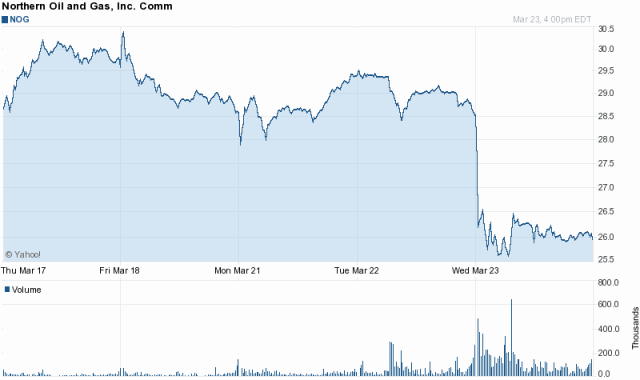Investors in Petrobakken (TSX: PBN) are continuing to discover why yield is not something that should be chased lightly – although they are probably looking at their 6.7% current yield on the $14.27 share price are feeling smug, the approximate 36% depreciation in share price over the past year is something they likely would have not wanted in conjunction.
The latest news out of Petrobakken is something they didn’t announce. Specifically, the following comes from their last quarterly financial release (for the 3 months ended March 31, 2011):
Note 9 – Bank Debt
The Company maintains a covenant based revolving credit facility with a syndicate of banks. The facility’s lending amount has a borrowing capacity of $1.2 billion. The current term for the facility ends June 3, 2011 and can be extended by the lenders for an additional year. If the lenders were not to extend the term, the drawn amount would become due on June 3, 2012. The credit facility bears interest at the prime rate plus a margin based on a sliding scale ratio of PetroBakken’s debt to earnings before interest, depletion, depreciation and amortization (“EBITDA”). The facility is secured by a $2.0 billion demand debenture and a securities pledge of Company’s assets.
June 3 has come and is nearly three weeks past. No extension of the credit facility has been announced so it is probable that the $966 million in bank debt (which will be higher for the second quarter financial release) will be called on June 2012. So this means that the clock has started for PBN to shop around for a billion dollars of financing – will they sell more debt? Or will they give the banks some more interest?
In terms of the rate that is being charged by the banks for the facility:
The applicable margin charged by the bank is based on a sliding scale ratio of PetroBakken’s debt to earnings before interest, taxes, depletion, depreciation and amortization (“EBITDA”). The facility is secured by a $2.0 billion demand debenture and a securities pledge on the Company’s assets. The credit facility has financial covenants that limit the ratio of secured debt to EBITDA to 3:1, limit the ratio of total debt (total debt defined as facility debt plus the value of outstanding debentures in Canadian dollars) to EBITDA to 4:1, and limit secured debt to 50% of total liabilities plus total equity. The Company is in compliance with all of these covenants.
I couldn’t find explicitly what the rates were from the financial statements, but doing some arithmetic on the 2010 annual financial statements and subtracting the interest they paid from their US$750M convertible debenture issue, I believe Petrobakken paid prime (3%) for their bank debt in 2010.
You can be sure that the banks want something more than prime for this round of financing – if the renewed credit facility charges prime plus 100bps, this will be another $10M/year in pre-tax cash that will be going out the window for PBN shareholders as the cheap financing dries up.
Petrobakken continues to remain on my radar, but as I stated in my “value trap” article, even at present valuations I will not be touching it. My guess continues to be that we will see a dividend cut or even floating a very unattractive (for them) equity financing in conjunction with a renewal of the credit facility. PBN still has a market capitalization of $2.6 billion and they could sell off 10-15% of the company and raise roughly $250-$500M which would reduce the debt-to-equity and keep their costs of borrowing at prime-like rates.



